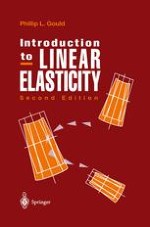1994 | OriginalPaper | Buchkapitel
Energy Principles
verfasst von : Phillip L. Gould
Erschienen in: Introduction to Linear Elasticity
Verlag: Springer New York
Enthalten in: Professional Book Archive
Aktivieren Sie unsere intelligente Suche, um passende Fachinhalte oder Patente zu finden.
Wählen Sie Textabschnitte aus um mit Künstlicher Intelligenz passenden Patente zu finden. powered by
Markieren Sie Textabschnitte, um KI-gestützt weitere passende Inhalte zu finden. powered by
The theory of elasticity may be developed from energy considerations, leading to the field equations in the form of differential equations. This approach does not promise any computational advantage from the standpoint of analytical solutions, since the same equations found from the classical formulations are produced. However, for the pursuit of numerical solutions, energy methods are extensively developed and are the basis of powerful contemporary programs for solving complex problems in solid mechanics. This development is rather recent and was brought about by the use of the digital computer. This probably explains the relatively few applications of energy methods to elasticity problems found in the classical texts. However, even in the 18th century, the mathematician Leonhard Euler contrasted the direct formulation of the governing differential equations, known then as the method of effective causes, with the energy approach, known then as the method of final causes, in an argument that skillfully blended science and theology (this may have been diplomatic considering the well-known plight of perhaps the first “elastician,” Galileo, a century earlier). Euler wrote [10.1]
